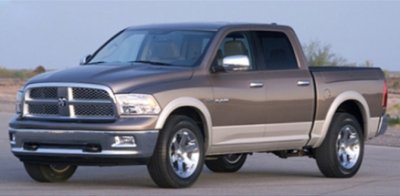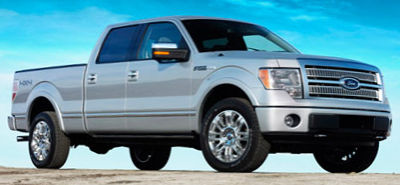 All Entries Tagged With: "dodge vs. ford"
All Entries Tagged With: "dodge vs. ford"
2009 Ford F150 vs 2009 Dodge Ram – Ride, Handling, and Comfort – Part Three
The third and final part of our 2009 Dodge Ram and 2009 Ford F150 comparison – see Part One – Mechanicals and Part Two – Features – to get up to speed.
RIDE:
You can feel the extra weight and all the rigidity of the F-150; Ford stuck with the tried-and-true rear leaf springs, but added six-inches to the spring length for both load capacity and ride smoothness. The F-150 drives like a truck with enough sedan comfort to keep your kidneys intact.
The Ram’s rear coil-overs do give Dodge’s half-ton a true car-like ride quality. The ’09 whipped around corners somewhat like a sports car, no doubt a result of the new suspension design. The five-link coil spring setup absorbs bumps and reduces friction, making for better handling and a nicer ride. The trade-off is reduced payload and tow capacities, but such is life. You can’t have it all.
Winner: Ram. The better ride really is the criteria here, but we stress that you should decide this one for yourself. Ride is important, but it depends on what you’re trying to accomplish in your truck. To paraphrase Raider’s quarterback Jim Plunkett, “If you want pretty, go to the ballet.” If you want a car-like ride, maybe you should buy a car.
HANDLING:
As we’ve said in other comparison tests, handling goes hand-in-hand with ride. Both vehicles put the driver in control, or at least give him or her the impression they’re in control (taking into consideration the countermeasures taken by a slew of invisible electronics). Slalom testing reveals little when it comes to pickups, mostly because there’s no real-world equivalent to good slalom test performance. The two trucks performed similarly (54.6 mph for the Ram, 56.5 mph for the F150) with the Ford edging out the Ram ever so slightly.
However, the news here is that the older design – the F150’s good old-fashioned leaf springs – performed similarly. We’re not big fans of the Ram’s coil rear suspension because it hampers towing, and one of the benefits is supposed to be better handling. Yet that’s not how the tests went…
Winner: F150. Ties go to older designs. The Ram should have performed better considering it gave up 2000 lbs in towing capacity to gain ride and handling, but we’ll have to put this “should’ve in sack, mister.”
COMFORT:
A true test of comfort takes much more time than we had available. In a perfect world, a few weeks of testing would have given us a very clear picture. Still, both offered controls that were highly visible, handy and intuitive. The Ram Laramie’s top-of-the-line gadgetry was great (or intimidating, depending on your perspective), and the basics were where you expected them to be. The F-150 is not as quiet as the Ram, but we have a hard time taking points away for a nicely tuned exhaust and motor “noise.”
Winner: The Ram, but it’s a very close call. All of our testers agreed the Laramie’s interior was the most welcoming.
OVERALL WINNER
The Ram’s superior engine, interior and exterior features, and ride didn’t really hold much of a candle to the F150’s advantages in capability (due in large part to the Ford’s 6 speed transmission and more rugged suspension). Considering that the F150 edged out the Ram in price and safety, it’s hard to believe there’s really a choice between these two trucks. Don’t get us wrong – the Ram’s superior looks (inside and out) and great featurse are nothing to be ashamed of. There’s nothing bad about the Ram…but there’s nothing it does especially better than the F150, either.
It says here that Chrysler’s decision to use a coil-spring rear suspension in the new Ram was a mis-step. Not only does the Ram have less capability than the F150, but it doesn’t ride or handle appreciably better to compensate for these shortcomings. It’s not that the Ram is a bad truck, it just doesn’t make much sense…at least not to us. Choosing the F150 over the Ram seems like the prudent choice across the board.
Dodge needs to do the following to the Ram in order to better match-up to the new F150:
- Add a 6-speed transmission
- Find a way to boost towing and payload capacities while simultaneously improving handling
- Improve safety ratings
- Cut costs
Considering Chrysler’s financial position, this seems like a tall order. With the volume of experts predicting a collapse at Chrysler, we certainly hope that this isn’t the last Dodge Ram…but we wouldn’t be surprised if that were the case.
2009 Ford F150 Vs 2009 Dodge Ram – Part One – Mechanicals
Here at TundraHeadquarters.com, there are two certainties: 1) We’re always writing new articles. Always. 2) We’re always going to be accused of bias, ignorance, and some variety of stupidity.
While the accusations of ignorance and stupidity don’t bother us too much (nobody’s perfect), the accusation of bias really irritates us. Whenever we complete a comparison – such as the Tundra vs F150, Tundra vs Ram, or Tundra vs Sierra-Silverado comparisons – we’re inevitably accused of bias. After all, the name of the site is TundraHeadquarters, so we must be biased towards the Tundra.
Riiiiiiight – that’s why we’re leading the charge against Toyota regarding the Tundra bed bounce issue, reporting about a possible decline in Tundra resale value, and sending out press releases about the Tundra bumper rust issues. We love the Tundra so much, we’re looking for new ways to criticize it…but we’re getting off-topic.

2009 Dodge Ram
What about comparing two vehicles that we don’t care about – the new 2009 Ford F150 and the new 2009 Dodge Ram? Which is the better truck?

2009 Ford F150

